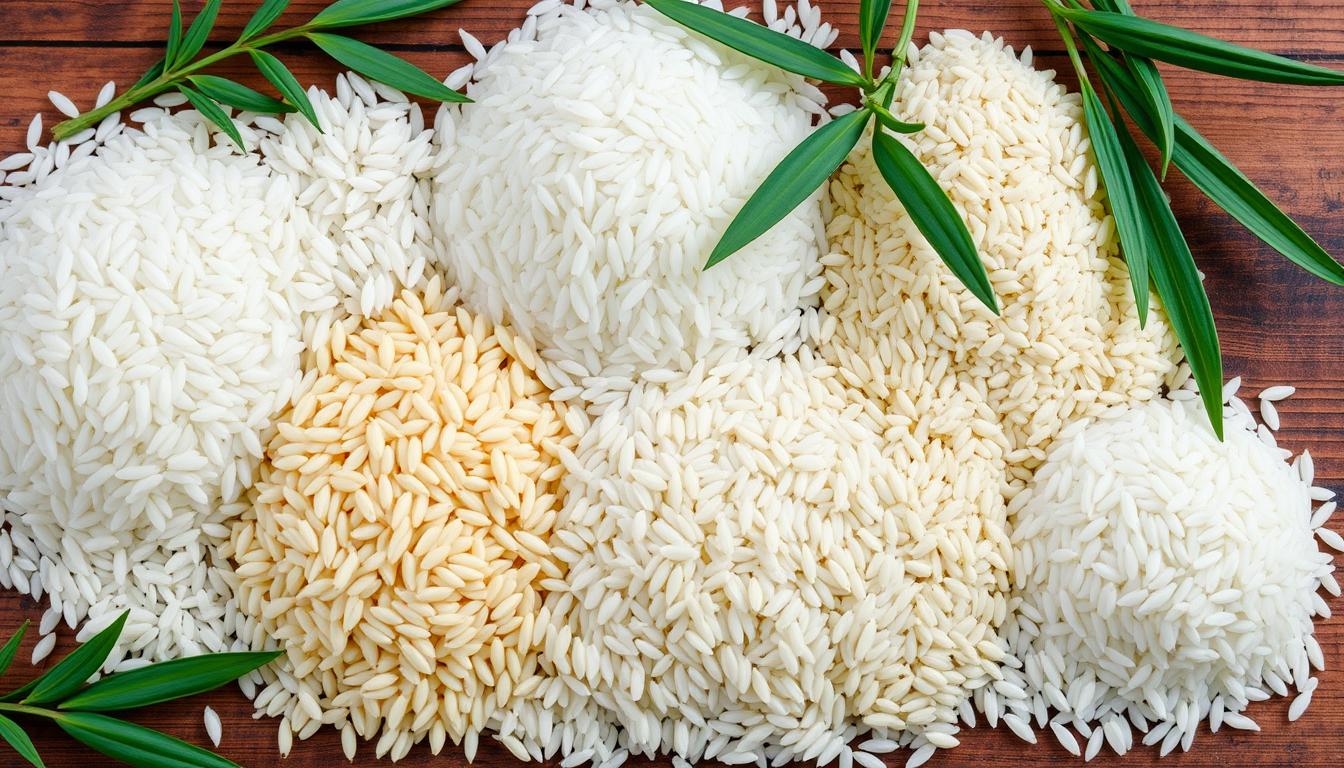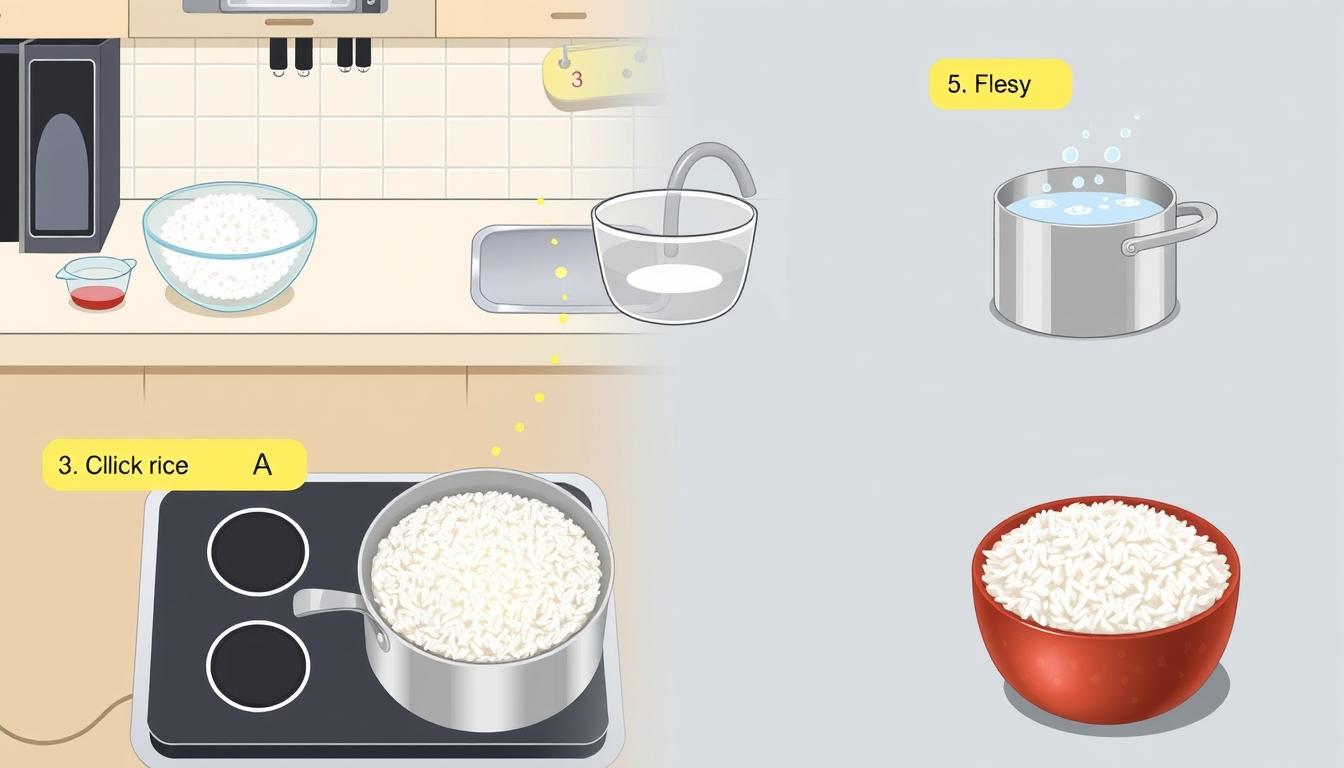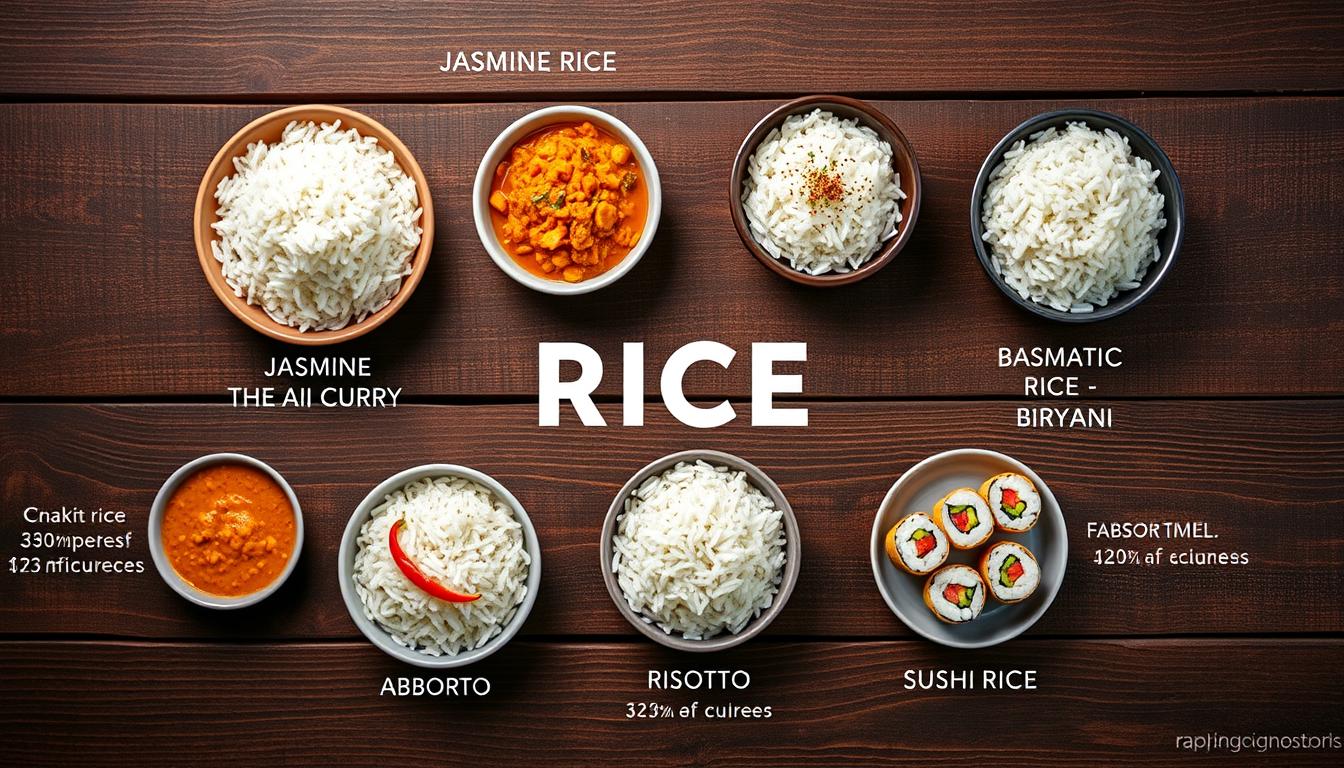Knowing the Rice-to-Water Ratio Chart is key for anyone who cooks rice often. It helps you get the right amount of water for each type of rice. This ensures your rice always turns out delicious.
This guide will walk you through different rice types, like white long grain and wild rice. You’ll learn the exact measurements and cooking times needed. Whether you’re new to cooking or have lots of experience, learning the right ratios will make your rice perfect every time.
The Importance of Rice-to-Water Ratios in Cooking
Cooking rice right depends on knowing the right rice-to-water ratios. These ratios are key to any good rice cooking guide. For example, long-grain white rice needs a 1-to-2 ratio. This means using two cups of water for every cup of rice.
This basic knowledge is essential for cooking rice well.
Understanding the Basics
Getting rice right means using the right amounts. A rice water ratio calculator helps you get it just right. Each rice type is different. For example, white rice needs a 1.5:1 ratio, and sushi rice needs 1.25 cups of water per cup of rice.
Why Accurate Measurements Matter
Using the right amounts is key for two reasons. It prevents rice from being too soggy or dry. Different rice types need different water ratios. For example, Bomba rice needs 2.5 cups of water per cup of rice, and Arborio rice for risotto needs three cups of liquid.
Using the wrong ratio can ruin your dish.
How Ratios Affect Rice Texture
The texture of rice changes with the water-to-rice ratio. Long-grain rice absorbs more water, making it fluffier and less sticky. Short-grain rice, on the other hand, is stickier because it absorbs less water. Knowing these differences helps you make the perfect rice dish for any meal.
Rice-to-Water Ratio Chart: Measurements for Every Type of Rice
Knowing the right rice-to-water ratio is key for perfect rice. Each rice type needs a specific amount of water to cook well. Here are the details for common rice types and their ratios.
Common Rice Varieties and Their Ratios
| Rice Type | Rice-to-Water Ratio | Cooking Time |
|---|---|---|
| Long Grain White Rice | 2 cups water for 1 cup rice (2:1) | 15-18 minutes |
| Brown Rice | 2¼ cups water for 1 cup rice (2¼:1) | 45 minutes |
| Basmati Rice | 1¾ cups water for 1 cup rice (1¾:1) | 18-20 minutes |
| Thai Jasmine Rice | 1½ cups water for 1 cup rice (1½:1) | 15-20 minutes |
| Arborio Rice | 3 cups of liquid for 1 cup rice (3:1) | 25-30 minutes |
| Short Grain (Sushi) Rice | 1¼ cups water for 1 cup rice (1.2:1) | Monitor closely |
| Bomba Rice | 2½ cups of water for 1 cup rice (2.5:1) | Varies |
Cooking Times for Different Types of Rice
Cooking times vary for different rice types. For instance, long-grain white rice cooks in 15 to 18 minutes. Brown rice, on the other hand, takes about 45 minutes. Knowing these times helps avoid overcooking or undercooking.
How to Use the Chart Effectively
To use the chart well, measure rice and water accurately. Use a rice-to-water calculator to make cooking easier. This helps in achieving consistent results and improving your cooking skills.
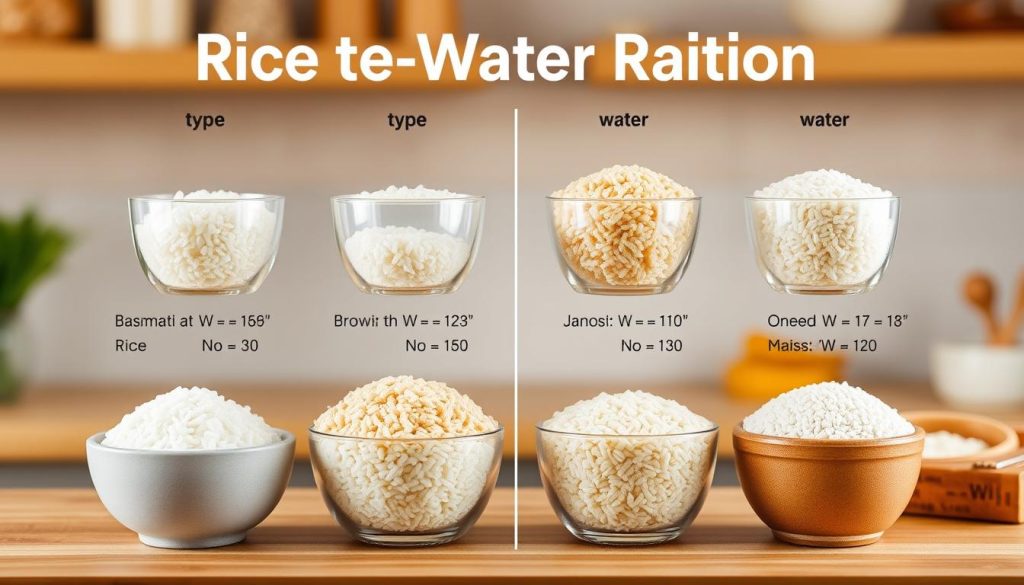
Cooking Methods: How to Perfectly Cook Rice
Preparing rice perfectly can seem challenging, but various cooking methods will help you achieve delicious results. Whether you prefer traditional techniques or modern appliances, understanding these cooking rice methods elevates your meals. Dive into each method to find the one that suits your schedule and taste.
Stovetop Cooking Method
The stovetop rice preparation remains the most traditional way to cook rice. It allows you to have precise control over the process. For optimal results, combine 1 cup of rice with 2 cups of water. Bring it to a boil before reducing the heat to low and simmering for approximately 18 minutes. This method results in a fluffy texture, making it a popular choice among rice cooking methods.
Microwave Method
Microwave rice cooking is a fantastic option for quick rice preparations. To cook, combine 1 cup of rice with 2 cups of water in a microwave-safe dish. Microwave on high for about 10 minutes, then cover and let it sit for another 3 minutes. This user-friendly method yields fluffy rice, perfect for those busy weeknights.
Using a Slow Cooker
For a no-fuss approach, consider slow cooker rice recipes. Simply grease the slow cooker and mix rice and water at a usual ratio of 1:2. Allow it to cook for 2 to 2.5 hours on high. The slow cooker allows the flavors to meld beautifully, creating a satisfying side dish or base for a flavorful meal.
Instant Pot Cooking Techniques
The Instant Pot revolutionizes the cooking process, enabling rapid meal prep while delivering perfect rice. Use a water-to-rice ratio of 1:1. Cook on high pressure for about 3 minutes, followed by a natural pressure release. This method is ideal for those who desire quick results without sacrificing texture or flavor.
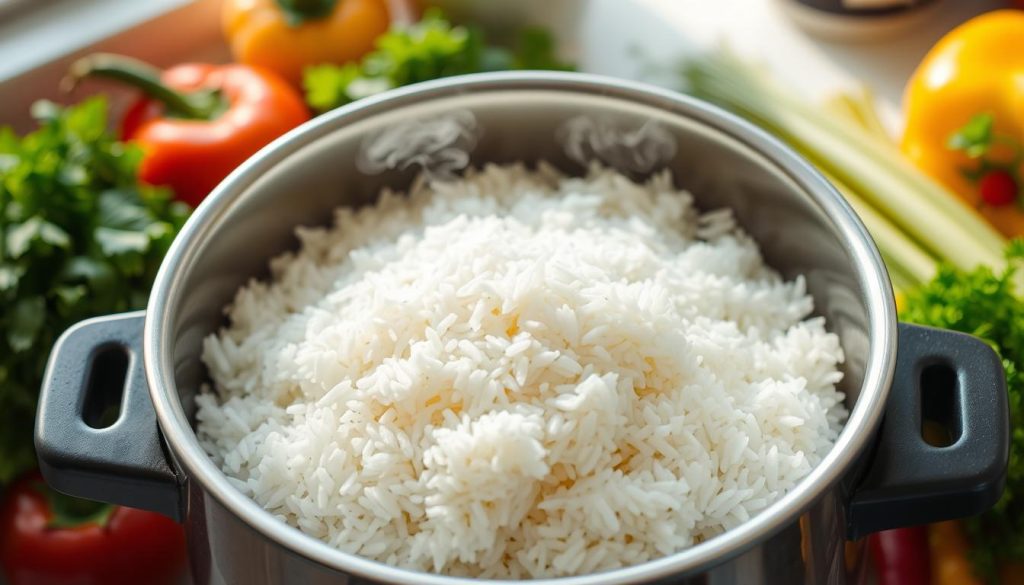
| Cooking Method | Ratio (Rice:Water) | Cooking Time | Serving Yield |
|---|---|---|---|
| Stovetop | 1:2 | 18 minutes | 2 cups cooked |
| Microwave | 1:2 | 10 + 3 minutes | 2 cups cooked |
| Slow Cooker | 1:2 | 2-2.5 hours | 2 cups cooked |
| Instant Pot | 1:1 | 3 minutes | 2 cups cooked |
Tips for Adjusting Ratios Based on Rice Type
Cooking rice perfectly means making adjustments based on the grain type. Knowing the grain types helps a lot. Each type—short, medium, and long grain—needs different water ratios. This affects the rice’s texture and consistency.
Understanding Grain Types: Short, Medium, and Long
It’s important to know the differences between short, medium, and long grains. Short-grain rice is stickier and fluffier, needing a 1:1 water ratio. Medium-grain rice, like Arborio, needs about 1:1.25 water. Long-grain rice, such as Basmati and Jasmine, might need up to 1:1.75 water. These ratios help each rice type cook perfectly, giving the right texture.
How Rinsing Affects the Cooking Process
Rinsing rice removes excess starch, making it less sticky. This improves the rice’s texture. When rinsing, you’ll need to adjust the water amount. Use less water for rinsed rice to get the best results.
Less starch means fluffier grains that stay separate. This is important for the rice’s texture.
Common Mistakes to Avoid
To avoid rice disasters, watch out for common mistakes:
- Using the wrong water ratios
- Not keeping the lid on while cooking
- Not letting the rice rest after cooking
- Not adjusting water for rinsed rice
To avoid rice disasters, measure water carefully and know cooking times. Each grain needs special care. Letting the rice rest for about 10 minutes after cooking helps it have the best texture.
Conclusion
Learning the right rice-to-water ratio is key to making perfect rice every time. Over half of the world eats rice as a main food. Knowing how to adjust ratios for different rice types is vital.
For example, long grain rice needs 1 ¾ to 2 cups of liquid. Medium or short grain rice only needs 1 ½ cups. This helps you make delicious, fluffy rice that goes well with your meals.
Remember, different rice types have their own cooking times and liquid needs. Brown rice, for instance, takes longer and needs more water—2 to 2 ½ cups. This makes it hearty. Using a reliable rice-to-water ratio chart helps you adjust your cooking methods.
Whether you’re using the stovetop, microwave, or Instant Pot, it ensures success. In summary, using the right ratios and cooking techniques makes your meals better. It also improves your cooking skills.
Make these methods a part of your daily cooking. Enjoy making perfectly cooked rice for you and your family. A little care can turn a simple dish into a meal highlight.
Source Links
- Rice to Water Ratio Calculator for all types of rice
- Cooking Rice for Beginners: Rice to Water Ratios
- This Is How Much Water You Need To Cook Rice
- Simmering Rice | Exploratorium
- Quick Guide for Rice Varieties and How to Use Them | Mahatma® Rice
- This Is How Much Water You Need To Cook Rice
- Rice Cooker Rice Ratio & Recipe Rice Cooker Rice: Ratios, Servings, & Recipe
- Rice to Water Ratio Calculator
- Failproof Instant Pot Rice
- How to Cook Rice – The Ultimate Guide
- All About Cooking Rice | UNL Food
- How to Cook Rice in Instant Pot (With Cooking Times) Live Simply
